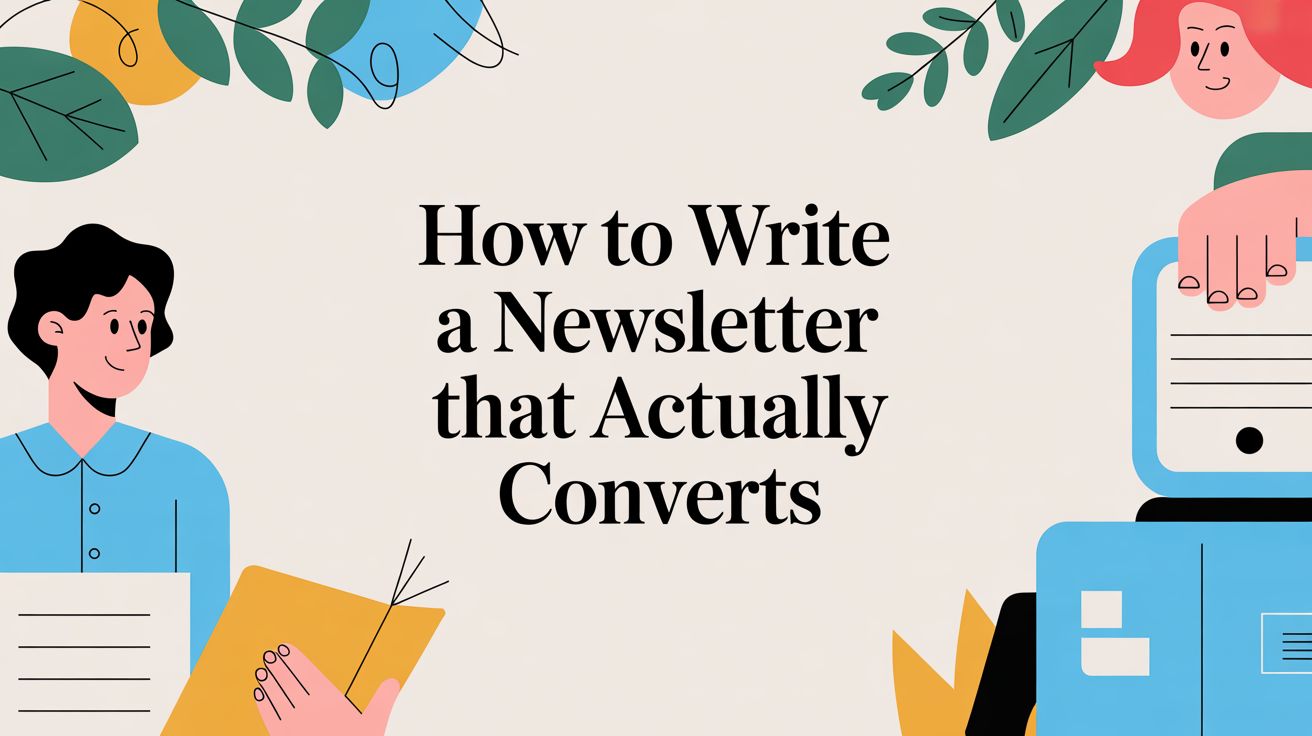
How to Improve Online Sales: A Guide to Boosting Revenue with Psychology
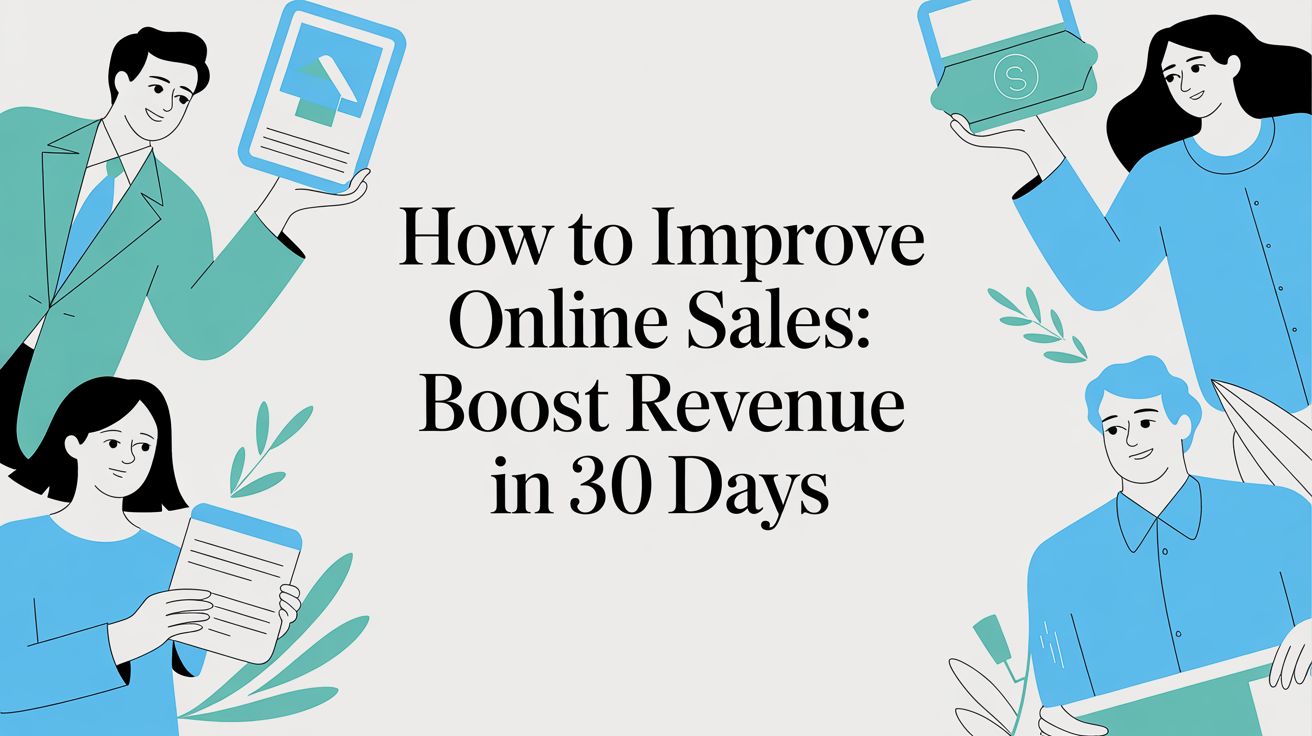
If you want to improve online sales, you need to move beyond simple discounts and tap into the core psychological drivers that compel people to buy now. The key is not just creating urgency, but understanding the science behind it.
This is about applying sophisticated, science-backed strategies from behavioral economics to give shoppers a compelling reason to stop browsing and start buying. It’s about creating shopping "Moments" that feel both natural and necessary, directly impacting your revenue and ROI.
Why Urgency Is Your Most Powerful Lever for Increasing Online Sales
The e-commerce landscape is fiercely competitive. The average conversion rate hovers around a mere 2.5%. Shoppers are distracted, endlessly comparing prices, and abandoning carts at an alarming rate—industry benchmarks place that figure at a staggering 70%.
The primary hurdle is overcoming consumer inertia. That’s where a deep understanding of behavioral economics becomes your most powerful tool for revenue growth.
Sophisticated urgency marketing isn't about manipulation. It’s about applying proven psychological principles to enhance the shopping journey. This approach is a world away from basic countdown timer apps or generic pop-ups focused on email capture. Instead, it puts the focus squarely on driving immediate sales, protecting profit margins, and improving inventory management.
The Science Behind Why People Buy
At its heart, urgency marketing activates specific cognitive biases that drive decision-making. By mastering these principles, you can build strategies that genuinely connect with shoppers and deliver a measurable impact on your bottom line.
Here are the core psychological drivers you need to know:
- Scarcity: A principle from behavioral economics stating that people place a higher value on things that are in short supply. Limited-quantity product drops or a simple "Only 3 left!" message makes an item feel far more exclusive and desirable.
- Fear of Missing Out (FOMO): A powerful social anxiety that arises when people believe they might miss out on a rewarding experience that others are enjoying. Time-sensitive offers and showing how many other people are looking at an item taps directly into this feeling.
- Social Proof: We are socially conditioned to follow the crowd. When shoppers see others buying a product, it confirms they're making a good choice and lowers what psychologists call "purchase anxiety."
When you strategically layer these triggers, you create a persuasive experience that can dramatically boost conversions. This flowchart breaks down how they work together to guide a customer toward making a purchase.
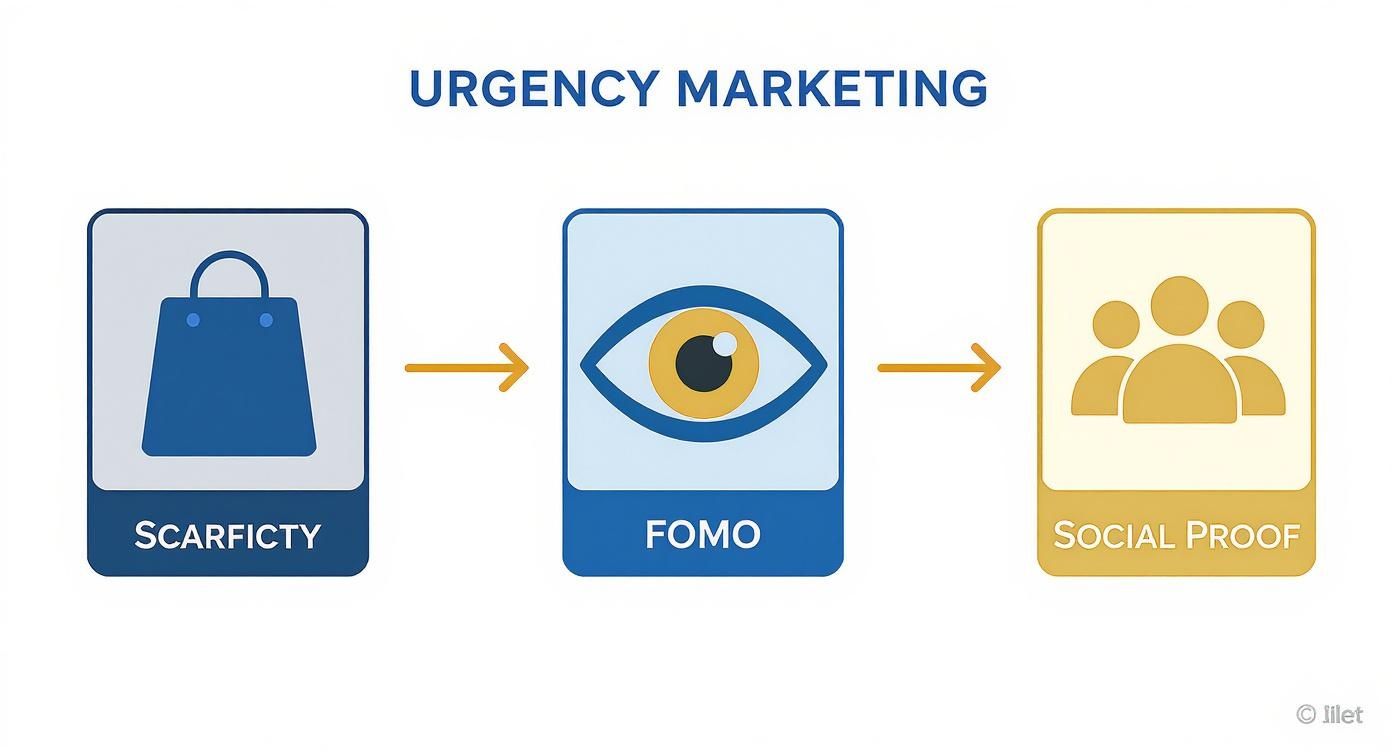
Understanding how these principles work together is fundamental. Below is a table that breaks down these core psychological triggers and how they translate into tangible e-commerce strategies.
Key Psychological Triggers for Ecommerce Growth
| Psychological Principle | Ecommerce Application | Expected Business Impact |
|---|---|---|
| Scarcity | Limited-edition product drops, low-stock indicators ("Only 2 left!"). | Increased perceived value, faster purchasing decisions, higher ROI on inventory. |
| Fear of Missing Out (FOMO) | Live countdown timers for sales, flash sales with a strict deadline. | Reduced cart abandonment, immediate sales lift during campaign periods. |
| Social Proof | "Best Seller" badges, showing "20 people bought this in the last hour". | Increased trust and credibility, higher conversion rates on product pages. |
| Urgency | Time-sensitive shipping offers ("Order in the next 2 hours for free shipping"). | Drives immediate action, increases average order value (AOV). |
| Anticipation | Announcing an upcoming product drop to an exclusive email list. | Builds excitement and demand before launch, ensuring a successful release. |
By strategically applying these triggers, you aren't just selling a product; you're creating a compelling event that encourages decisive action from your customers.
The goal is to create compelling shopping "Moments" where the decision to buy feels both natural and necessary. By mastering the science of urgency, brands can turn passive browsers into active buyers, leading to immediate ROI and better inventory management.
Platforms like Quikly are engineered to do this, giving Shopify merchants the power to automate sophisticated behavioral triggers without cheapening their brand, a common pitfall of basic timer apps.
To see just how powerful one of these principles can be, check out our complete guide to scarcity marketing and see how it can directly impact your sales.
Crafting a Winning Mobile Commerce Experience
Your customers aren't chained to a desktop. They're scrolling on their phones while waiting for coffee, browsing from the couch, or making a quick purchase during their commute. Ignoring this reality is one of the fastest ways to lose sales. A mobile-first strategy isn't just a good idea—it's essential for survival and growth.

The shift to mobile is monumental. In fact, mobile commerce is a dominant force, with projected sales expected to hit $2.51 trillion in 2025. That's a massive 21.25% jump from 2024's figures, cementing mobile as the primary channel for shoppers.
Simply having a "mobile-friendly" site won't cut it anymore. You must actively design for the mobile context. This means creating a seamless, intuitive experience that anticipates what a user needs on a small screen, where attention spans are short and patience is thin. A clunky, slow, or confusing mobile journey is a direct path to a lost sale.
Designing for Thumbs, Not Clicks
First, you have to think about the physical reality of mobile browsing. Most people navigate with one hand, primarily using their thumb. This simple observation has huge implications for your site's design and layout.
- Easy-to-Reach Navigation: Place your primary CTAs, menu, and cart icons within the natural arc of the thumb. Forcing users to stretch to the top corner of the screen creates unnecessary friction.
- Large, Clear Buttons: Tiny, tightly packed links are a recipe for frustration. Ensure all tappable elements are large enough to be easily selected without accidental clicks.
- Vertical Content Flow: Design your product pages and checkout flows for easy scrolling. Avoid horizontal scrolling or complex layouts that require pinching and zooming.
Think of it as an ergonomic challenge. A well-designed mobile experience feels effortless, guiding the user smoothly from discovery to purchase. If you're looking for more ways to enhance your user journey, check out our guide on 6 tips to improve your brand’s mobile app experience.
Streamlining the Mobile Checkout Funnel
Nowhere is a frictionless experience more critical than at checkout. The industry average cart abandonment rate hovers around a painful 70%, and a poorly optimized mobile checkout is a major culprit. Every extra field, every unnecessary step, and every moment of loading time increases the odds that a customer will bounce.
Your goal is to get the user from "Add to Cart" to "Purchase Confirmed" as quickly and painlessly as possible.
A superior mobile experience does more than just boost conversions; it directly protects your profit margins. By reducing checkout friction and cart abandonment, you lessen the need for expensive retargeting ad campaigns to win back customers you almost had.
For Shopify merchants, here are actionable takeaways you can implement now:
- Activate Shop Pay: This express checkout option lets returning customers complete their purchase in seconds with a single tap. It's a game-changer for reducing friction.
- Minimize Form Fields: Only ask for what is absolutely essential. Lean on autofill features and clear, simple labels.
- Offer Guest Checkout: Forcing account creation is a known conversion killer. Make it a choice, not a requirement.
Integrating Urgency on Small Screens
Urgency marketing is incredibly powerful on mobile, but it demands a different approach. Annoying, screen-blocking pop-ups are even more intrusive on a smaller display. The key is to be subtle and integrated.
Instead of disruptive pop-ups that just grab emails, think about using sophisticated behavioral triggers. Quikly's "Moments" are designed for this very purpose. They use non-intrusive banners and dynamic elements that enhance the mobile journey, not interrupt it.
Imagine a sticky banner at the top of the screen with a live countdown for a flash sale, or a subtle notification showing how many other shoppers are looking at an item. These tactics create powerful psychological motivators without wrecking the user experience, turning a casual mobile browse into an immediate sale.
Turning Product Pages into Conversion Powerhouses
Think of your product page as the final sales pitch. It's that critical moment where a curious browser decides to become a paying customer. To boost your online sales, this page can't just be a static catalog entry. It needs to be an active, persuasive conversion engine grounded in consumer psychology.
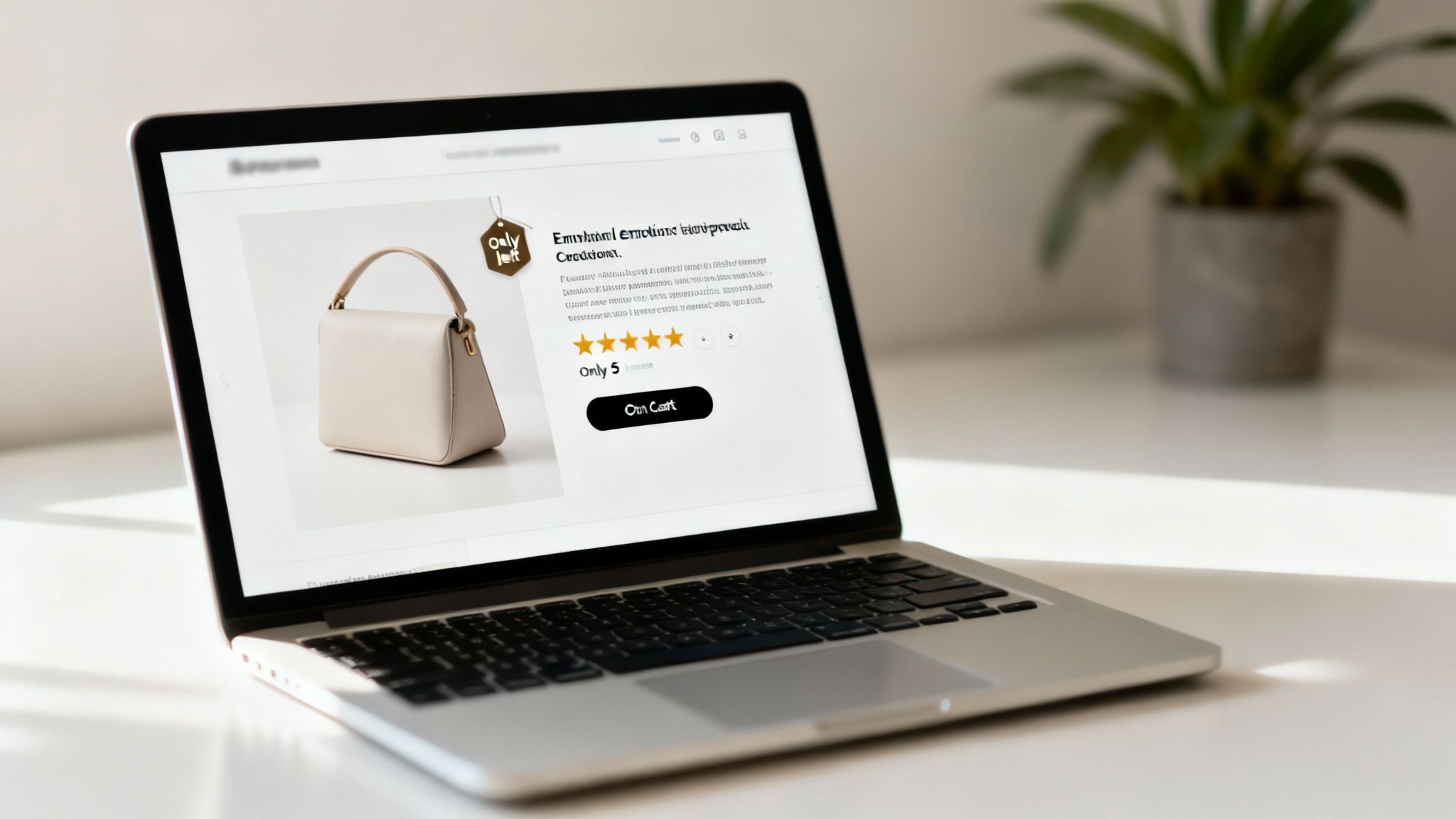
A great product page is built on three pillars: compelling copy, high-impact visuals, and undeniable social proof. When these elements work in harmony, they build trust, answer questions before they're asked, and forge an emotional connection with the shopper.
A big piece of this puzzle is writing compelling product descriptions that do more than just list features. Your goal is to articulate value and benefits. Instead of a dry rundown of specs, paint a picture of how your product solves a problem or improves your customer's life. That emotional hook is often the tipping point for a purchase.
Go Beyond Static Descriptions to Dynamic Action
Strong copy and beautiful images are the price of entry, but they're passive. To truly move the needle on product page conversions, you need to introduce dynamic urgency. This is where you shift from presenting a product to creating a live, interactive shopping experience built on proven behavioral psychology.
This approach transforms the page from an information hub into a decision-making catalyst. By layering in real-time context, you tap into powerful triggers like scarcity and social proof that nudge shoppers to take immediate action.
For anyone on Shopify, this means using tools that can display:
- Real-Time Scarcity: A message like "Only 5 left in stock!" instantly makes an item feel more valuable and exclusive. It creates a powerful sense of scarcity.
- Live Social Proof: Displaying "15 people are viewing this item right now" confirms the product’s popularity and sparks a fear of missing out (FOMO).
- Time-Sensitive Incentives: Adding a countdown timer to a product-exclusive offer encourages an immediate add-to-cart, cutting down on the procrastination that leads to abandoned carts.
These are smart applications of consumer psychology that give a customer a legitimate reason to buy now, directly tackling that moment of hesitation.
The Quikly Difference: Sophisticated Automation
Basic countdown timer apps can create a sense of urgency, but they often require manual setup and lack the intelligence to adapt to shopper behavior. This is where an advanced platform like Quikly stands apart, offering automated campaigns called "Moments" that are triggered by specific customer actions.
Instead of a generic site-wide timer, imagine launching a ranked offer exclusively on a high-traffic product page. The first 50 buyers who add the item to their cart within the next hour could get a special discount. This gamified experience builds genuine excitement and drives a much larger conversion spike than a simple "sale ends soon" banner ever could.
The key is moving from manipulation to motivation. Sophisticated urgency marketing provides authentic, time-bound opportunities that make the shopping experience more exciting and decisive for the customer, leading to higher revenue and better inventory turnover for the merchant.
This level of automation also protects your profit margins. You aren't just applying a sitewide discount that devalues your brand. You're creating targeted, high-impact events that drive sales for specific products exactly when you need to.
For Shopify Plus merchants, integrating these "Moments" with tools like Klaviyo or an SMS platform creates a powerful, multi-channel urgency campaign that guides the entire customer journey. To get ideas on how to visually tie all these elements together, check out our guide on creating high-impact Shopify banners.
The Psychology Behind a High-Converting Checkout
The journey from "Add to Cart" to "Complete Purchase" is where most sales are won or lost. Industry benchmarks show that roughly 70% of shoppers abandon their carts, representing a massive amount of unrealized revenue. To capture that revenue, you must stop thinking of your checkout as a transaction page and start treating it as a psychologically-tuned, frictionless experience.
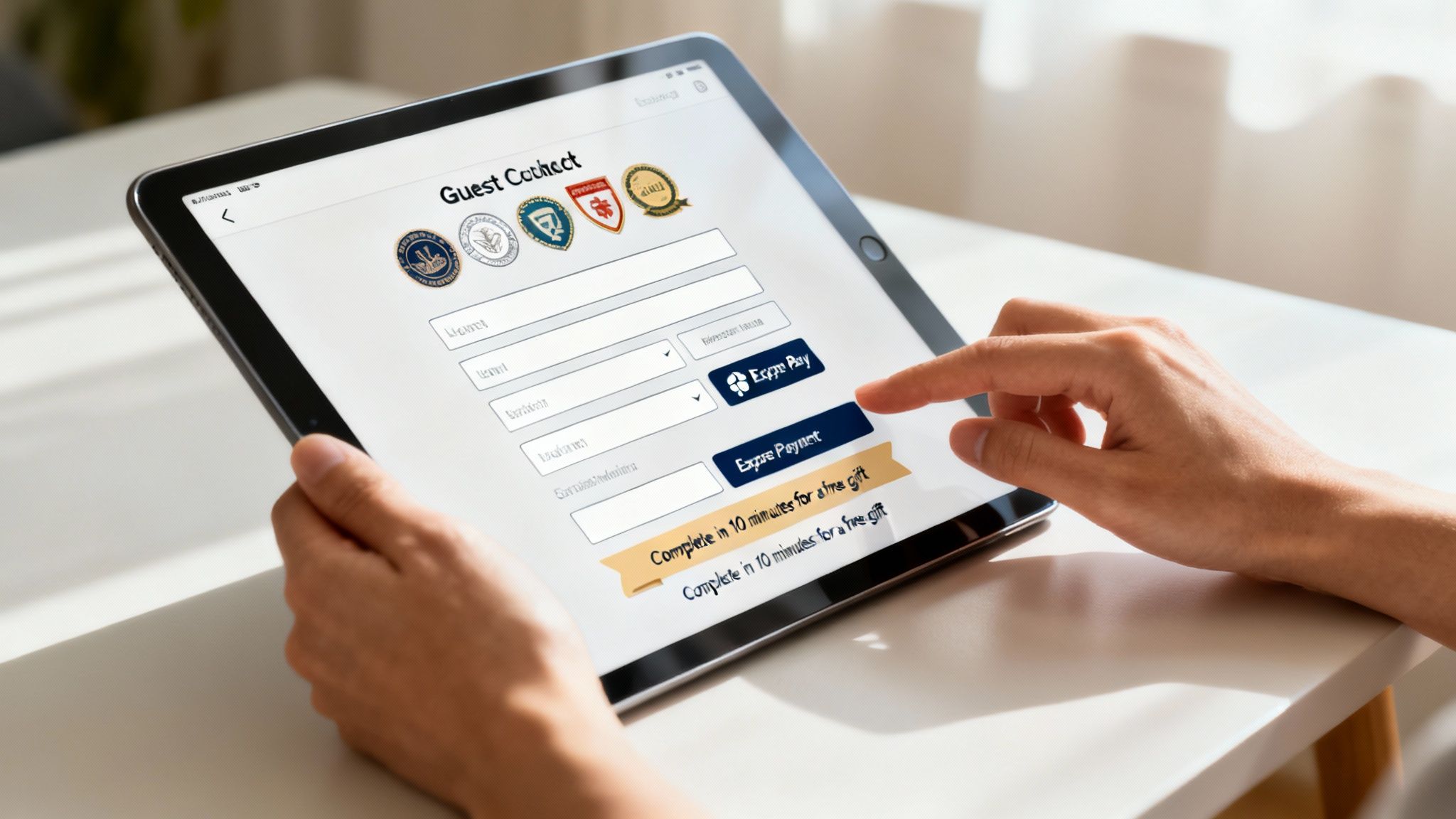
This final step is where shopper hesitation is at its peak. Any unexpected friction—a surprise shipping cost, a mandatory account sign-up—can trigger what behavioral economists call risk aversion. This causes potential customers to second-guess their decision and leave. Your job is to quiet that inner voice of doubt by minimizing cognitive load and building unshakable trust.
Laying the Foundation for a Frictionless Flow
Before implementing advanced tactics, you must master the fundamentals of a high-converting checkout. These are the non-negotiables that modern online shoppers expect.
Here are the essential components every store needs:
- Guest Checkout Option: Forcing account creation is a top reason for cart abandonment. Always provide a clear, easy guest checkout path.
- Minimal Form Fields: Only ask for what is absolutely necessary to process the order. Every extra field increases friction.
- Express Payment Methods: Integrate options like Shop Pay, Apple Pay, and Google Pay. These one-click solutions slash the effort required to buy, especially on mobile.
- Visible Trust Signals: Prominently display security badges (SSL certificates, McAfee, Norton) and payment logos. These visual cues reassure shoppers that their information is safe.
The core idea behind checkout optimization is simple: remove every possible point of friction. Think of a checkout flow as a waterslide—any bump or snag can grind the user to a halt. The smoother the ride, the more people make it to the end.
Elevating the Checkout with Advanced Urgency
Once you have a solid foundation, you can transform your checkout from a functional page into one that actively drives conversions. This is where you introduce sophisticated urgency marketing, turning that final step into a compelling nudge to buy now. It’s a world away from basic pop-up apps focused on email capture; here, the goal is to secure immediate revenue.
For merchants on Shopify Plus, the ability to customize the checkout process opens up powerful opportunities. Imagine integrating a platform like Quikly with your email and SMS tools, like Klaviyo. This allows you to introduce a compelling, last-second offer to convert a hesitant buyer.
Think about a shopper who has paused on the payment page. Instead of letting them become another abandonment statistic, a dynamic element appears, creating a powerful "Moment" built on proven psychological triggers.
Here are some actionable takeaways:
- Ranked Rewards: Introduce competition based on scarcity. A banner could appear saying, "Complete your purchase in the next 10 minutes and be one of the first 50 to receive a free gift." This taps into our desire for exclusivity and gamifies the final step.
- Last-Chance Shipping Upgrade: Offer a clear, time-bound incentive, like "Finalize your order in the next 5:00 minutes to get free express shipping." The benefit is immediate and the deadline is firm.
These strategies tap into real behavioral triggers like anticipation and social proof ("be one of the first"). By presenting a valuable, time-sensitive opportunity at the moment of hesitation, you provide a powerful reason to complete the purchase—directly boosting sales and protecting margins by converting a customer who might have otherwise required expensive retargeting ads.
Boosting Lifetime Value and Average Order Value
Sustainable growth isn't just a constant chase for new customers. The most profitable e-commerce brands know the secret to boosting online sales is to maximize the value of the customers you already have.
This means focusing on two critical levers: Average Order Value (AOV) and Customer Lifetime Value (LTV).
Shifting your strategy beyond one-time transactions is key. Instead of pouring all your energy into that first conversion, you need to build experiences that get customers to spend more on each order and—more importantly—keep them coming back. This is where you get smart with data-driven upselling and sophisticated retention plays that turn casual shoppers into brand advocates.
Driving Higher AOV with Strategic Upsells
One of the most direct ways to increase immediate revenue is to encourage shoppers to add more to their cart before checkout. To move the needle on the value of each customer, lean into proven strategies like effective upselling and cross-selling techniques. This is about making helpful suggestions at just the right moment.
For Shopify merchants, here are some actionable ideas:
- Product Bundles: Group complementary products together for a small discount (e.g., a camera, lens, and memory card). This increases perceived value and simplifies the shopping process.
- "Frequently Bought Together" Suggestions: Use an app to dynamically show products that other customers often buy together. This leverages social proof to guide purchasing decisions.
- Tiered Shipping Thresholds: A banner stating, "You're only $15 away from free shipping!" is an incredibly powerful motivator that nudges customers to add one more item to their cart.
These tactics work because they genuinely help the customer while directly increasing your AOV and immediate ROI.
Fueling LTV with Urgency and Exclusivity
While AOV provides an immediate lift, LTV is the engine for long-term, sustainable profit. Retaining an existing customer is far more cost-effective than acquiring a new one. The key to retention is making loyal customers feel like insiders by leveraging the powerful psychology of anticipation and exclusivity.
This is where a platform like Quikly goes beyond basic pop-ups. The entire focus shifts from simple email capture to creating high-stakes "Moments" that reward loyalty and drive repeat purchases.
The core idea behind LTV-focused urgency is to treat your existing customer base like a VIP club. By creating exclusive, time-sensitive events, you tap into a powerful sense of belonging and anticipation that a generic 10% discount code just can't touch.
Imagine launching a limited-edition product only available to previous customers. Announce this exclusive event through targeted email and SMS campaigns using your Klaviyo integration. This creates a powerful feedback loop: customers feel rewarded for their loyalty, which encourages another purchase, deepening that loyalty.
This strategy builds a community around your brand, protects your profit margins by avoiding sitewide sales, and improves inventory management by creating predictable demand spikes.
The global e-commerce market is exploding, with 85% of consumers now shopping online. With the average revenue per user projected to hit $1,130, focusing on retention is the smartest way to capture a larger share. By turning one-time buyers into loyal repeat customers, you’re building a resilient business that thrives on loyalty, not just fleeting transactions.
Measuring Success and Optimizing for Profit
Launching urgency tactics is just the beginning. The real growth happens when you stop chasing vanity metrics and start obsessing over the numbers that truly matter: Return on Investment (ROI), profit margins, and Customer Lifetime Value (LTV).
This is the key difference between reactive discounting and building a strategic, profitable growth engine. It’s one thing for a countdown timer to boost conversions, but did it erode your margins by training customers to wait for a discount? Answering that question is what separates the pros from the amateurs.
A Framework for Profitable Optimization
Adopt a rhythm of continuous testing and learning. Start by A/B testing different psychological triggers to see what truly resonates with your audience.
For example, pick a key product and run two different campaigns:
- Campaign A (Scarcity): A limited-quantity drop. "Only 100 units available at this price."
- Campaign B (Urgency): A limited-time offer. "This discount expires in 48 hours."
The data might reveal that the scarcity campaign drove slightly fewer sales but delivered a 5% higher profit margin. That's the kind of insight that protects your bottom line while driving revenue—a nuance most basic timer apps completely miss.
The goal isn’t to find a single silver bullet. It's to build a repeatable cycle: test, learn, and optimize. Let hard data, not gut feelings, guide your marketing decisions. This ensures every campaign contributes to a healthier P&L and smarter inventory management.
The Power of Sophisticated Automation
Manually managing intricate tests and campaigns is not just difficult; it's nearly impossible to do effectively at scale. This is where a true automation platform like Quikly becomes a game-changer for serious Shopify Plus merchants.
Instead of getting bogged down setting up dozens of one-off campaigns, sophisticated automation lets you create complex, behavior-driven "Moments" that run autonomously.
This approach frees up your team from the tedious work associated with basic pop-up tools, allowing them to focus on high-level strategy. Your urgency marketing transforms from a sporadic tactic into a core, profitable component of your e-commerce engine, always working in the background to improve your online sales.
Got Questions? We've Got Answers
Let's address some of the most common questions brands have about using psychology-driven strategies to achieve real, sustainable growth.
How Can I Create Urgency Without Cheapening My Brand?
This is the most critical question. The secret is to shift your mindset from manipulation to motivation. Ground every tactic in genuine value and proven behavioral science, not generic discounts.
Create compelling "Moments" that add to the customer experience. A limited-edition product drop, for instance, taps into the powerful psychological principles of scarcity and anticipation. Offering early access to VIPs leans into exclusivity. These are not cheap tricks; they add a layer of excitement and value, making your brand feel more premium, not less.
What’s the Difference Between Urgency and Scarcity?
They are often used interchangeably, but they are distinct psychological triggers. Understanding the difference is key to a precise strategy.
- Urgency is time-based. It answers the question, "Why should I buy this now?" A flash sale with a live countdown timer is a classic urgency tactic.
- Scarcity is quantity-based. It answers, "Why should I want this more than other items?" A notification like "Only 3 left!" is scarcity at work.
The most powerful strategies combine them. A limited-quantity item available for only 24 hours creates an incredibly compelling reason for shoppers to act immediately.
The goal of sophisticated urgency marketing isn't just to sell faster; it's to sell smarter. When you apply these psychological principles correctly, you can boost revenue, protect your margins, and gain better control over your inventory.
Can Urgency Tactics Actually Increase Average Order Value?
Absolutely. Urgency is not just for the final "buy" button click. It can be woven into the entire shopping journey to encourage customers to add more to their cart.
Here’s a perfect, actionable example for Shopify merchants: a time-sensitive shipping threshold. A dynamic banner at the top of your site that says, "Add $15 more to your cart in the next 10:00 minutes for free express shipping!" doesn't just create a deadline; it uses a time-based incentive to directly increase AOV before a customer even reaches the checkout.
Ready to stop just setting timers and start building a real revenue-driving engine? Quikly gives you the tools to run sophisticated, psychology-backed campaigns that drive sales while protecting your profits. Learn more and see how it works today.

The Quikly Content Team brings together urgency marketing experts, consumer psychologists, and data analysts who've helped power promotional campaigns since 2012. Drawing from our platform's 70M+ consumer interactions and thousands of successful campaigns, we share evidence-based insights that help brands create promotions that convert.
